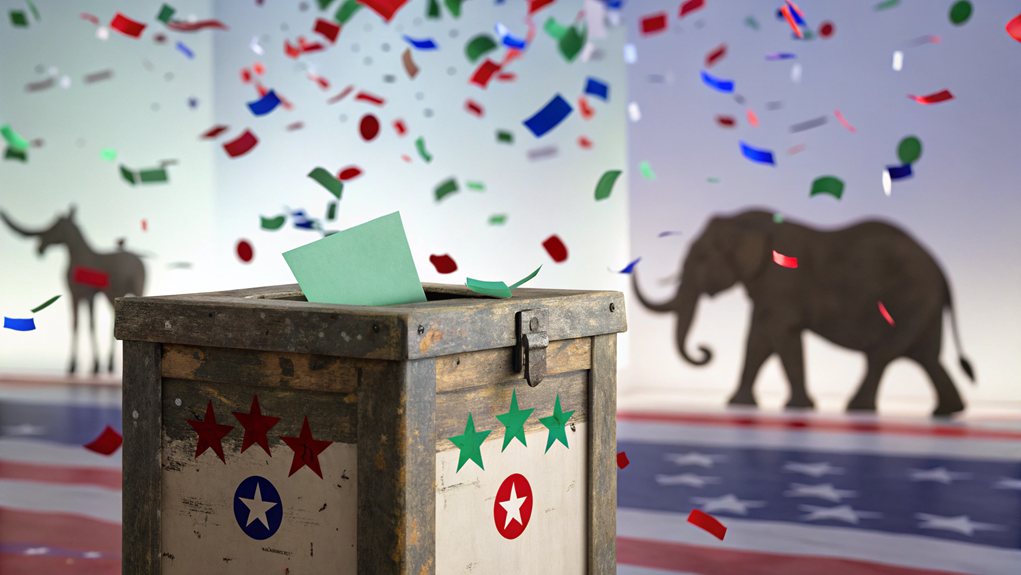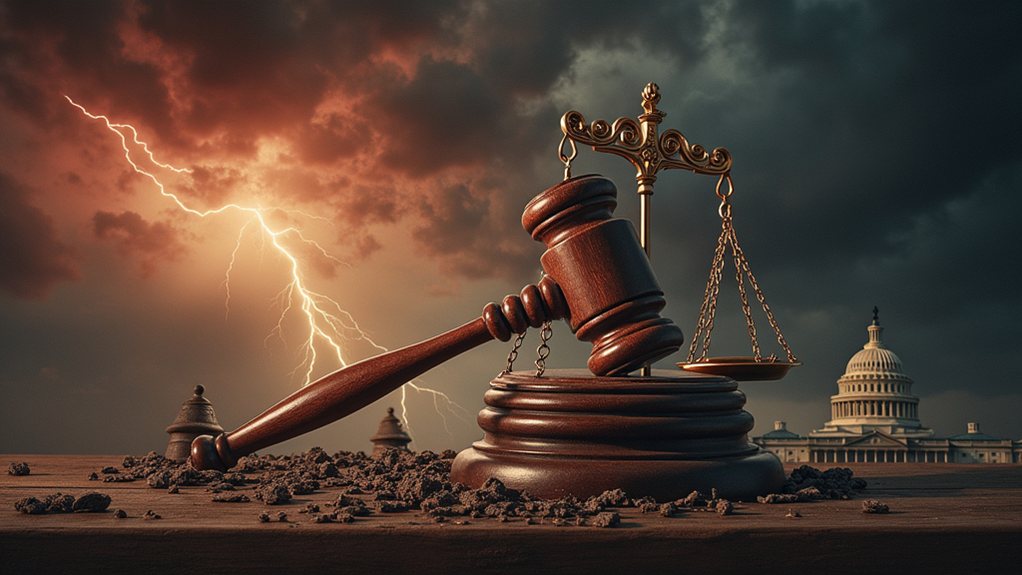Third parties shake up American elections. They raise issues the big guys ignore. Ever heard of the Populists or Ross Perot? Yeah, they made waves. But let's be real: the system is rigged. Winner-take-all? Hard pass for third-party candidates. Limited media? Check. Unfair ballot access? You bet. Still, they hold the major parties accountable and push for fresh ideas. It's not just about winning; it's about making noise. And there's more to this story, so stick around.

Third parties in American elections have always been the underdogs, often fighting against a system stacked against them. They defy the odds, but let's be real: it's a tough road. Historically, they've made splashes, even if they rarely make waves.
Take the Populist Party back in 1892. James B. Weaver captured about 9% of the vote. Not a win, but it showed potential. Fast forward to 1912, and Theodore Roosevelt's Progressive Party took a hefty 27% of the popular vote. That's impressive, but was it enough? Nope.
Then there's George Wallace in 1968. He snagged five states with the American Independent Party and got 13.5% of the vote. It's like a party trick: "Look, I can win some states!" Ross Perot made waves in 1992, pulling 19% of the vote and forcing budget deficits into the spotlight. Not bad for a businessman with a quirky campaign style.
George Wallace and Ross Perot showcased third-party flair, grabbing votes and shaking up the political scene—talk about making waves!
Third parties often raise issues the big guys ignore. The Socialists pushed for women's suffrage and child labor laws. The Populists introduced concepts like the 40-hour workweek, which eventually influenced the Fair Labor Standards Act. Historical third-party candidates remind us that new ideas can emerge even in a dominant two-party system. In fact, more than 54 political parties exist in the U.S., showing a rich tapestry of political thought beyond the mainstream. The evolution of political parties in America illustrates how these third parties have historically created shifts in the political landscape by challenging the status quo.
Then there's the Green Party, waving its environmental flag, and the Libertarians, advocating for less government. They keep major parties on their toes, reminding them of forgotten issues.
But let's be honest: the challenges are real. The winner-take-all system is a nightmare for third-party candidates. Campaign finance laws? Tough luck unless you hit certain thresholds. Media coverage? Good luck getting any! And don't even get started on ballot access. It's like a maze with flaming hoops.
In the end, third parties can split votes and mess with major party outcomes. They often push for change, only to find themselves sidelined. So, while they might not win, their impact is undeniable. They're like the little engine that could, except sometimes, it doesn't.
Frequently Asked Questions
How Do Third Parties Influence Voter Turnout in Elections?
Third parties definitely shake things up when it comes to voter turnout.
They capture the attention of those who feel ignored by the big players. Sure, they rarely win, but they can get people off the couch and into the voting booth.
Think of them as the spicy salsa in a bland taco; they make folks reconsider their options.
It's a mixed bag—more choices, but still a tough road to real success.
What Role Do Third Parties Play in Debates?
Third parties in debates? Yeah, good luck with that.
They often get sidelined thanks to strict criteria. You need 15% in polls to even show up—most can't touch that.
When they do make it, they shake things up, introducing fresh topics. But let's be real: they get little media love, so they struggle for traction.
Still, audiences crave that diversity. Spoiler alert: major parties may even steal their ideas. How charming!
Can Third Parties Affect Major Party Policies?
Absolutely, third parties can shake things up. They toss new ideas into the ring, making major parties sweat.
Think about the Populists pushing for direct senator elections or the Green Party dragging environmental issues into the limelight.
Sure, they rarely win, but they can force big players to adopt their platforms.
It's like they're the pesky little siblings of politics, constantly nudging the giants to pay attention and change their ways.
How Do Third Parties Fund Their Campaigns?
Third parties fund their campaigns through a mix of individual donations, party committee support, and those oh-so-lovely PACs and Super PACs.
They can raise big bucks, thanks to the unlimited spending loophole. Soft money? Yes, please!
It's a wild west of funding, with some groups hiding behind dark money tactics. Not to mention, they hustle hard with voter drives and media ads.
But hey, they still face a mountain of financial hurdles!
Are Third-Party Candidates Eligible for Federal Funding?
Third-party candidates? Federal funding? Good luck with that!
They need to snag at least 5% of the popular vote first. Yeah, that's a tall order.
And if they think they can just waltz in, think again. They also have to raise over $5,000 in 20 states for matching funds.
Plus, they're under strict spending limits. So, basically, it's like trying to climb Everest without any gear. Good luck!








